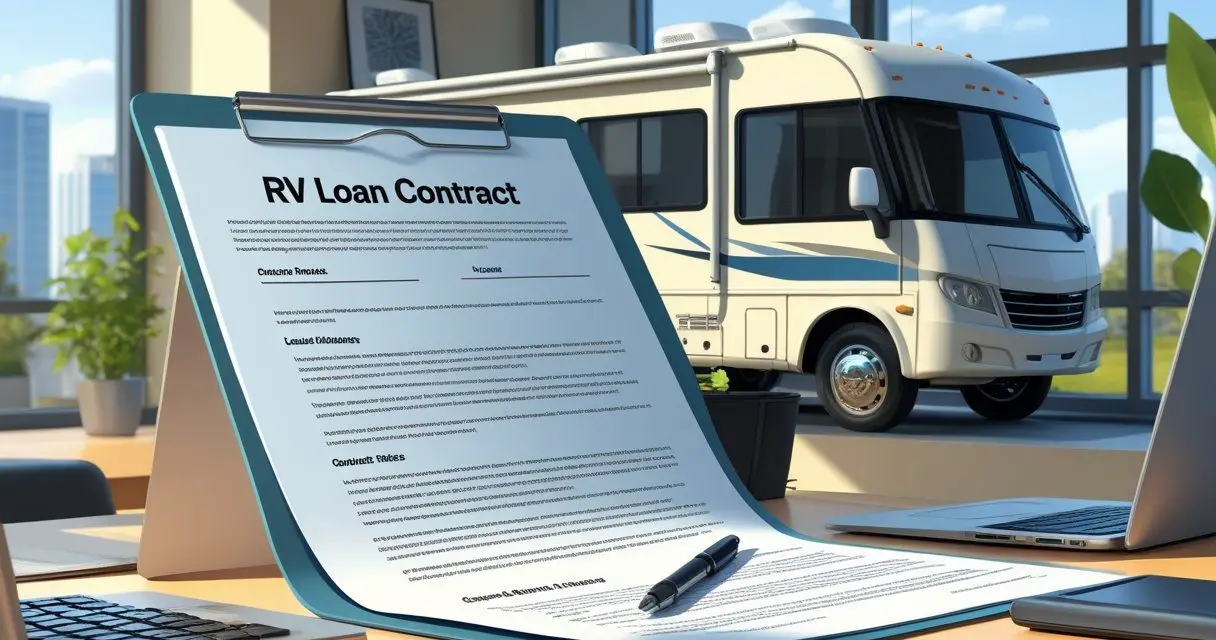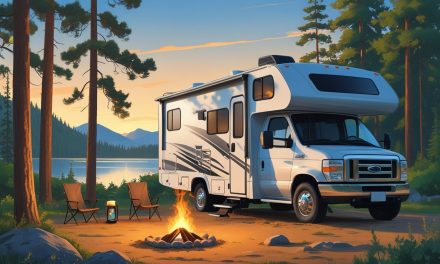Would you like to save this article?
You’ve enjoyed countless memories in your RV, but circumstances change. Perhaps you’re facing financial challenges, relocating overseas, or simply ready to upgrade to a different model. Whatever your reason, you’re now faced with a significant question: “Can someone assume my RV loan?” when you still have years of payments ahead.
Many RV owners find themselves in this exact situation. You’ve invested thousands in your recreational vehicle, but life circumstances now require you to part ways with it. The challenge? You still have a substantial loan balance, and selling outright means coming up with enough cash to pay off the loan completely—something that might not be financially feasible right now.
This comprehensive guide will walk you through everything you need to know about RV loan assumption—from determining if your loan is eligible for assumption to navigating the transfer process and exploring alternatives if assumption isn’t an option. We’ll provide practical advice to help you make informed decisions about your RV financing situation.
Understanding RV Loan Assumption: What It Means
RV loan assumption is a financial arrangement where a new buyer takes over your existing RV loan with the same terms, interest rate, and remaining balance. The new borrower essentially steps into your shoes, assuming responsibility for the ongoing payments while taking ownership of the RV.
This process differs significantly from traditional refinancing or getting a new loan. With loan assumption, the original loan terms remain unchanged—the interest rate, payment schedule, and loan duration stay exactly the same. Only the responsible borrower changes.
How RV Loan Assumption Differs from Other Transfer Methods
It’s important to distinguish loan assumption from other ways of transferring an RV with an outstanding loan:
- Loan assumption: The new buyer legally takes over your exact loan with lender approval, assuming all rights and responsibilities.
- Refinancing: The buyer gets an entirely new loan with potentially different terms to pay off your existing loan.
- Informal payment takeover: Someone makes payments on your behalf without legal transfer (extremely risky and not recommended).
- Selling and paying off the loan: You sell the RV and use the proceeds to clear the loan balance completely.
Legal and Financial Implications
Loan assumption carries significant legal and financial implications for both parties:
For the original borrower (you):
- Release from loan obligation (if fully approved)
- Potential impact on credit history
- Transfer of RV ownership and associated responsibilities
For the assuming borrower:
- Legal responsibility for all remaining payments
- Inheritance of existing loan terms (interest rate, duration)
- Acquisition of RV title upon loan completion
The RV Loan Assumption Process: Step-by-Step
Successfully transferring your RV loan to another person requires following a structured process. Here’s a detailed breakdown of how to navigate the RV loan assumption journey:
How to Check if Your Loan is Assumable
Not all RV loans can be assumed. Here’s how to determine if yours qualifies:
- Review your loan agreement: Look for sections titled “Assumption,” “Transfer,” or “Due-on-Sale.” These will outline if assumption is permitted.
- Contact your lender directly: Speak with your loan servicer to confirm their current assumption policies.
- Check loan type: Some loans, particularly those from credit unions or RV-specific lenders, are more likely to allow assumptions than traditional bank loans.
Keep in mind that even if your loan documents don’t explicitly prohibit assumptions, the lender may still have discretion in approving any transfer. Interest rates play a significant role—lenders are typically more resistant to allowing assumptions of loans with below-market interest rates.
Lender Requirements and Restrictions
If your loan is potentially assumable, be prepared for these common lender requirements:
- Processing fees ranging from $300-$800
- Assumption application forms
- Current RV appraisal or valuation
- Inspection of the RV’s condition
- Verification that the loan is current with no missed payments
- Proof of insurance from the new borrower
Some lenders may also have restrictions based on:
- Loan age (newer loans may be harder to assume)
- Remaining balance thresholds
- Geographic limitations (some only allow assumptions within certain states)
Credit and Income Qualifications for the New Borrower
The person assuming your loan will typically need to meet similar or even stricter qualification standards than you did originally. Lenders generally require:
- Credit score: Typically 650+ for RV loan assumptions, with better terms for scores above 700
- Debt-to-income ratio: Usually below 45%, meaning monthly debt payments shouldn’t exceed 45% of monthly income
- Income verification: Recent pay stubs, tax returns, or bank statements
- Employment history: Stable employment, typically 2+ years in the same field
- Down payment: Some lenders require the new borrower to pay a percentage of the remaining balance as a down payment
Required Documentation
Both you and the assuming borrower will need to prepare documentation:
From you (current owner):
- Current loan statement showing balance and payment history
- RV title (if you have it) or title information
- Maintenance records and service history
- Bill of sale or transfer agreement
- RV registration documents
From the assuming borrower:
- Completed loan assumption application
- Proof of identity (driver’s license, passport)
- Proof of income and employment
- Credit authorization
- Insurance proof or application
Step-by-Step Transfer Procedure
- Initial contact with lender: Notify your lender of your intention to have someone assume your loan.
- Assumption application: The potential buyer completes the lender’s assumption application.
- Credit and income verification: The lender evaluates the buyer’s creditworthiness.
- RV appraisal and inspection: The lender may require an assessment of the RV’s current condition and value.
- Assumption approval: If approved, the lender prepares assumption documents.
- Signing and processing: Both parties sign the assumption agreement and pay any required fees.
- Title transfer: Complete the title transfer according to your state’s DMV requirements.
- Release of liability: Obtain written confirmation that you’re released from loan obligation.
This process typically takes 2-6 weeks, depending on the lender and how quickly documentation is provided.
Pros and Cons of RV Loan Assumption
Before proceeding with an RV loan assumption, it’s important to understand the potential benefits and drawbacks for both parties involved.
Benefits for the Seller (Original Borrower)
Advantages for Sellers
- Financial relief: Release from monthly payment obligations
- Credit protection: Avoid potential negative credit impacts from selling an RV with an underwater loan
- Simpler than refinancing: No need to come up with cash to cover any loan-to-value gap
- Faster sale potential: More buyers may be interested if they can assume favorable loan terms
- Avoid early payoff penalties: Some loans have prepayment penalties that assumption avoids
Disadvantages for Sellers
- Potential continued liability: Some lenders may not fully release you from obligation
- Limited buyer pool: Only buyers who qualify under lender’s criteria
- Process complexity: More paperwork and time than a standard cash sale
- Lender resistance: Some lenders actively discourage or prohibit assumptions
- Fees and costs: Assumption fees can be substantial
Benefits for the Buyer (New Borrower)
Advantages for Buyers
- Potential interest rate savings: May assume a loan with lower interest rate than current market rates
- Reduced closing costs: Generally lower fees than establishing a new loan
- Simplified process: Less paperwork than a new loan application
- Shorter loan term: Take over a partially-paid loan rather than starting a new 10-15 year term
- Possible equity advantage: If the RV is worth more than the loan balance
Disadvantages for Buyers
- Strict qualification requirements: May need better credit than for a new loan
- Limited negotiation: Cannot change loan terms or duration
- Cash gap payment: Must pay the difference if RV value exceeds loan balance
- Inherited loan age: Older loans may have less favorable terms
- Potential condition issues: RV may have wear and tear or maintenance needs
Ready to Explore Your RV Loan Assumption Options?
Whether you’re looking to assume an RV loan or have someone assume yours, understanding your options is crucial. Get personalized advice based on your specific loan situation.Speak With a Loan Specialist
Alternatives to RV Loan Assumption
If your RV loan isn’t assumable or you can’t find a qualified buyer willing to assume it, several alternatives exist. Each has its own advantages and considerations:
Refinancing Options
Refinancing involves replacing your current loan with a new one, potentially with better terms:
- Traditional refinancing: You refinance to a lower interest rate or longer term to reduce monthly payments.
- Buyer refinancing: The buyer obtains their own loan to pay off your existing loan.
- Cash-out refinancing: If you have equity in your RV, you might refinance for more than you owe and use the difference to address other financial needs.
Refinancing works best when interest rates have dropped since you obtained your original loan or when your credit score has improved significantly.
Selling and Paying Off the Loan
A traditional sale might be your best option in some circumstances:
- Positive equity sale: If your RV is worth more than you owe, sell it and use the proceeds to pay off the loan.
- Savings contribution: If underwater on your loan, you might need to contribute personal savings to cover the difference at sale.
- Negotiated payoff: In some cases, lenders might accept a reduced payoff amount if you’re experiencing financial hardship.
Lease-to-Own Arrangements
A lease-to-own agreement can be a creative solution:
- How it works: You lease your RV to a potential buyer who makes payments to you, and you continue making loan payments.
- Contract terms: The agreement specifies that after a certain period, the lease payments will count toward purchasing the RV.
- Legal structure: This requires careful legal documentation to protect both parties.
This option works best when you find a buyer who needs time to build credit or save for a down payment but is committed to eventually purchasing the RV.
Voluntary Surrender or Trade-In
In more challenging situations, you might consider:
- Dealer trade-in: Trading your RV to a dealer for a less expensive model, potentially reducing your loan obligation.
- Voluntary surrender: As a last resort, returning the RV to the lender (though this will negatively impact your credit).
These options typically result in less favorable financial outcomes but may be necessary in certain hardship situations.
Legal Considerations and Protections
RV loan assumptions involve significant legal considerations that both parties should understand before proceeding:
Contract Requirements
A proper loan assumption requires several legally binding documents:
- Assumption agreement: The formal contract between you, the buyer, and the lender
- Release of liability: Documentation releasing you from future loan responsibility
- Bill of sale: Transfers ownership of the RV itself
- Title transfer: Legal documentation filed with your state’s DMV
- Disclosure statements: Information about the RV’s condition and history
Never rely on verbal agreements or handwritten contracts for loan assumptions. Always use proper legal documentation prepared or reviewed by qualified professionals.
State-Specific Regulations
RV loan assumptions are subject to varying state laws that can significantly impact the process:
- Title transfer requirements: Each state has different procedures for transferring vehicle titles.
- Tax implications: Some states charge sales tax on assumed loans based on the remaining balance.
- Consumer protection laws: Certain states offer additional protections for vehicle financing transfers.
- Registration requirements: The assuming buyer may need to register the RV in their name within a specific timeframe.
Consult with a local attorney familiar with your state’s vehicle financing laws to ensure compliance with all regulations.
Protecting Both Parties’ Interests
Both the original borrower and the assuming buyer should take steps to protect themselves:
For sellers (original borrowers):
- Obtain written release of liability from the lender
- Verify the transfer of insurance responsibility
- Document the RV’s condition at transfer with photos and inspection reports
- Remove personal property and verify address changes
For buyers (assuming borrowers):
- Conduct thorough RV inspection before assumption
- Verify loan details directly with the lender
- Obtain service records and warranty information
- Confirm clear title with no additional liens
Practical Tips for Successful RV Loan Assumption
Based on experiences from successful RV loan assumptions, here are practical strategies to improve your chances of a smooth transfer:
Working with Lenders Effectively
Your approach to lenders can significantly impact the assumption process:
- Start with the right contact: Ask specifically for the department that handles loan assumptions or transfers.
- Get everything in writing: Document all conversations, including representative names and confirmation numbers.
- Be persistent but professional: Some lenders may initially discourage assumptions; politely ask to review your loan agreement terms.
- Highlight positive payment history: Emphasize your excellent payment record if applicable.
- Consider timing: Submit assumption requests early in the month, when loan departments are typically less busy.
Finding Qualified Buyers
Finding someone who can qualify for your loan assumption requires targeted strategies:
- Be upfront about requirements: Clearly communicate credit score and income requirements in your listing.
- Target appropriate platforms: Use RV-specific marketplaces where buyers understand financing.
- Pre-screen potential buyers: Ask about credit scores and financial qualifications before proceeding to serious discussions.
- Highlight assumption benefits: Emphasize advantages like potentially lower interest rates compared to current market rates.
- Consider working with an RV broker: Professionals can help find qualified buyers and navigate the assumption process.
Navigating the Paperwork Process
Managing documentation efficiently can save weeks of processing time:
- Create a complete document package: Gather all required paperwork before contacting the lender.
- Use a checklist: Create a comprehensive list of required documents for both parties.
- Submit everything together: Provide complete packages rather than piecemeal documents.
- Follow up regularly: Check on application status weekly but avoid excessive contact.
- Consider professional assistance: An attorney or document preparation service can ensure proper completion.
Need Help With Your RV Loan Assumption?
Our network of RV financing specialists can help you navigate the assumption process or explore alternatives if assumption isn’t possible.Get Expert Assistance
Frequently Asked Questions About RV Loan Assumption
Can all RV loans be assumed?
No, not all RV loans can be assumed. Whether a loan is assumable depends on the specific terms in your loan agreement and your lender’s policies. Generally, loans from credit unions and RV-specific lenders are more likely to allow assumptions than traditional bank loans. Government-backed loans (similar to FHA or VA loans for homes) are also more commonly assumable. Always check your loan documentation or contact your lender directly to confirm.
What happens to the original borrower’s credit after loan assumption?
If the loan assumption is properly executed with a full release of liability, the loan should no longer appear as an active obligation on your credit report. However, the payment history up to the point of assumption remains on your credit history. A properly handled assumption should not negatively impact your credit score and may actually help it by reducing your debt-to-income ratio. Without a formal release of liability, you could remain responsible for the loan if the new borrower defaults, which could severely damage your credit.
How long does the RV loan assumption process typically take?
The RV loan assumption process typically takes between 2-6 weeks from application to completion. Simple assumptions with well-qualified buyers might be completed in as little as 10-14 business days. More complex situations or lenders with extensive requirements may take 8 weeks or longer. The timeline depends on several factors: lender responsiveness, buyer qualification complexity, required inspections or appraisals, and how quickly both parties provide required documentation.
What are the typical costs involved in an RV loan assumption?
Costs for RV loan assumption typically include:
- Assumption fee: $300-$800 charged by the lender
- Credit check fee: $25-$50 for the assuming borrower
- Title transfer fee: Varies by state, typically $15-$150
- Registration fees: Varies by state and RV value
- Documentation preparation: $50-$300 if using professional services
- RV inspection: $150-$400 if required by the lender
Additionally, if the RV is worth more than the loan balance, the buyer will need to pay you the difference between the loan amount and the agreed purchase price.
Can I assume an RV loan with bad credit?
Assuming an RV loan with bad credit is challenging but not always impossible. Most lenders require the assuming borrower to meet similar or stricter credit requirements than the original loan approval. Typically, a credit score of at least 650 is needed, with better terms for scores above 700. However, some factors may help overcome credit challenges:
- Substantial down payment to reduce lender risk
- Strong income and employment stability
- Low debt-to-income ratio despite credit score issues
- Co-signer with excellent credit
Some smaller lenders or credit unions may be more flexible, especially if the assuming borrower can demonstrate that past credit issues were due to one-time circumstances that have been resolved.
What if my RV is worth less than what I owe on the loan?
If your RV is “underwater” or has “negative equity” (worth less than the loan balance), loan assumption becomes more complicated but may still be possible. Options include:
- The assuming buyer pays the regular payments but negotiates a lower purchase price, accepting that they’ll initially have negative equity
- You (the seller) contribute the difference as a down payment to the lender to bring the loan in line with the RV’s value
- The assuming buyer brings additional cash to cover the equity gap
Some lenders may refuse assumptions on underwater loans due to increased risk. In these cases, you might need to consider alternatives like continuing payments until you reach positive equity or exploring voluntary surrender options.
Conclusion: Making the Right Decision About Your RV Loan
Navigating RV loan assumption requires careful consideration of your specific situation, loan terms, and available options. While loan assumption can be an excellent solution for transferring RV ownership without completely paying off the loan, it’s not available or appropriate for everyone.
Key takeaways to remember:
- Always start by confirming whether your specific loan is assumable by reviewing your loan agreement and contacting your lender.
- Understand that loan assumption requires lender approval and the assuming buyer must meet credit and income requirements.
- Protect yourself legally by obtaining proper documentation, especially a release of liability from the lender.
- Consider alternatives like refinancing, traditional sales, or lease-to-own arrangements if assumption isn’t possible.
- Work with qualified professionals (financial advisors, attorneys) when navigating complex financial transactions.
Whether you’re looking to exit your RV loan due to financial changes, lifestyle shifts, or simply to upgrade, taking the time to understand all your options will lead to better outcomes. With proper research, preparation, and professional guidance when needed, you can find a solution that protects your financial interests while allowing you to move forward with your changing RV ownership needs.





